Environmental Regulations in Brazil for Fashion
| República Federativa do Brasil Federative Republic of Brazil | |||||
| |||||
| Motto: Ordem east Progresso(Portuguese) "Gild and Progress" | |||||
| Canticle: Hino Nacional Brasileiro | |||||
| | |||||
| Upper-case letter | Brasília 15°45′South 47°57′Westward | ||||
|---|---|---|---|---|---|
| Largest city | São Paulo | ||||
| Official languages | Portuguese | ||||
| Ethnic groups | 48.43% White 43.fourscore% Brown (Multiracial) 6.84% Black 0.58% Asian 0.28% Amerindian | ||||
| Government | Federal presidential ramble republic | ||||
| - President | Jair Bolsonaro | ||||
| - Vice President | Hamilton Mourão | ||||
| - President of the Sleeping accommodation of Deputies | Rodrigo Maia | ||||
| - President of the Senate | Eunício Oliveira | ||||
| - Chief Justice | Dias Toffoli | ||||
| Independence | from Kingdom of Portugal | ||||
| - Alleged | 7 September 1822 | ||||
| - Recognized | 29 Baronial 1825 | ||||
| - Republic | 15 Nov 1889 | ||||
| - Electric current constitution | 5 Oct 1988 | ||||
| Area | |||||
| - Full | km² (fifth) 3287597 sq mi | ||||
| - Water (%) | 0.65 | ||||
| Population | |||||
| - 2019 estimate | 210,147,125[i] | ||||
| - Density | 25/km² 63/sq mi | ||||
| GDP (PPP) | 2019 estimate | ||||
| - Total | $3.524 trillion[ii] | ||||
| - Per capita | $16,727[2] | ||||
| Gdp (nominal) | 2019 gauge | ||||
| - Total | $i.929 trillion[2] | ||||
| - Per capita | $9,159[2] | ||||
| HDI (2017) | 0.759 (high) | ||||
| Currency | Real (R$) (BRL) | ||||
| Time zone | BRT (UTC-two to -iv) | ||||
| - Summer (DST) | BRST (UTC-2 to -iv) | ||||
| Internet TLD | .br | ||||
| Calling code | +55 | ||||
Brazil, officially the Federative Republic of Brazil, is the largest land in South America. It is the world's fifth-largest state by expanse, the fifth most populous, and the fourth almost populous democracy in the earth. The Brazilian population tends to concentrate along the Atlantic coastline in big urban centers. While Brazil has i of the largest populations in the earth, its overall population density is low since the vast inland regions are sparsely populated.
Brazil is a racially diverse, multiracial land, and intermarriage among different ethnic groups has been part of the country's history. Some say that Brazil is a "post-racist" social club, equanimous of an agglomeration of all the races in the world, with no respect to color or number, perhaps capable of laying the basis of a new civilization.
By far the well-nigh populous country in South America, Brazil overcame more than half a century of armed forces intervention in the governance of the country when, in 1985, the military regime peacefully ceded ability to noncombatant leaders. Brazil continues to pursue industrial and agricultural growth and development of its interior. Utilizing vast natural resources and a big labor pool, it is today S America's leading economic power and a regional leader. Highly unequal income distribution remains a pressing problem.
Contents
- i Geography
- 1.ane Climate
- ane.2 Environment
- two History
- 2.1 Colonization
- 2.2 Empire
- 2.3 Republic
- 3 Government and politics
- 3.1 Foreign relations
- 3.2 Military
- 4 Administrative divisions
- 5 Economy
- 5.1 Energy policy
- 5.2 Scientific discipline and technology
- 6 Demographics
- 6.ane Languages
- half dozen.2 Education and health
- 6.three Social issues
- 7 Culture
- 7.1 Religion
- seven.2 Sports
- 8 Notes
- nine References
- 10 External links
- 11 Credits
The major theory for the source of its name states it was named subsequently brazilwood, an abundant species in the new-found country that was valuable in Portuguese commerce. This found has a strong red color, so "Brazil" is derived from the Portuguese word "brasa," meaning "ember."
Geography
Bounded by the Atlantic Bounding main on the due east, Brazil has a coastline of over 7,367 kilometers. It borders Venezuela, Suriname, Guyana, and French Guiana to the north, Uruguay to the south, Argentina and Paraguay to the southwest, Bolivia and Peru to the west, and Republic of colombia to the northwest. Numerous archipelagos are part of the Brazilian territory, such as Penedos de São Pedro due east São Paulo, Fernando de Noronha, Trindade e Martim Vaz, and Atol das Rocas.
Brazil is traversed by the Equator and Tropic of Capricorn and is dwelling house to varied fauna and flora, likewise every bit all-encompassing natural resource.
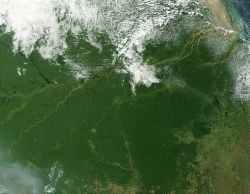
Brazilian topography is diverse, including hills, mountains, plains, highlands, scrublands, savannas, rainforests, and a long coastline. The extensive low-lying Amazon rainforest covers most of Brazil's terrain in the north; small-scale hills and low mountains occupy the south. Along the Atlantic coast there are several mount ranges, with altitudes of roughly 9,500 feet (2,900 thou). The highest peak is the nine,735 pes (3,014 m) Pico da Neblina (Misty Tiptop) in Guiana'south highlands. Major rivers include the Amazon, the largest river in terms of volume of water and the 2d-longest in the world; the Paraná and its major tributary, the Iguaçu River, where the Iguaçu Falls are located; as well equally the Negro, São Francisco, Xingu, Madeira, and Tapajós rivers.
Climate

Brazil's climate has little seasonal variation, since 90 percentage of the country is located within the torrid zone. However, the climate varies considerably from the by and large tropical north (the equator traverses the mouth of the Amazon) to temperate zones below the Tropic of Capricorn, which crosses the country at the latitude of the city of São Paulo. Brazil has five climatic regions: Equatorial, tropical, semiarid, highland tropical, and subtropical.
Temperatures forth the equator are high, but southern Brazil has subtropical temperate weather, unremarkably experiencing frost in the winter (June-August), and occasional snowfall in the mountainous areas, such as Rio Grande practice Sul and Santa Catarina. Temperatures in the cities of São Paulo and Brasília are moderate because of their altitude of approximately 3,000 feet (ane,000 m). Rio de Janeiro and Salvador, located on the coast, have warm climates.
Precipitation levels also vary widely, beingness higher in the humid Amazon Bowl and lower in the somewhat arid landscapes of the northeast. The bulk of Brazil has moderate rainfall, with about of information technology falling in the summertime (betwixt December and Apr), south of the Equator. The Amazon region is notoriously boiling, with rainfall of more than than 2,000 millimeters per year, getting as high equally 3,000 millimeters in parts of the western Amazon and virtually Belém. Despite high annual precipitation, the Amazon rainforest has a three-to-five month dry flavour.
Environs
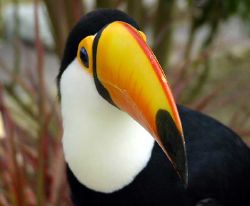
The Toco Toucan is a typical animal of the Brazilian rainforest.
Brazil's large area comprises unlike ecosystems, which together sustain some of the world's greatest biodiversity. Because of the country'south intense economical and demographic growth, Brazil'south power to protect its environmental habitats has increasingly come under threat. Extensive logging in the nation'due south forests, particularly the Amazon, destroys areas the size of a minor country each year, and potentially a various multifariousness of plants and animals. Between 2002 and 2006, an area of the Amazon rainforest equivalent in size to the U.S. land of South Carolina was completely decimated, for the purposes of raising cattle and logging. By 2020, it is estimated, at least fifty percentage of the species in Brazil may become extinct.
The Pantanal surface area of Brazil is considered past many to be the earth's largest, freshwater, wetland arrangement. It is ane of the most pristine and biologically rich environments on the planet. It also provides many economic benefits, including offer a huge expanse for water purification and groundwater discharge and recharge, climate stabilization, water supply, inundation abatement, and an extensive, transport system, amid numerous other important functions.
There is a general consensus that Brazil has the highest number of both terrestrial vertebrates and invertebrates of any single country in the world. Also, Brazil has the highest primate diverseness, the highest number of mammals, the 2d highest number of amphibians and collywobbles, the tertiary highest number of birds, and fifth highest number of reptiles. There is a high number of endangered species, many of them living in threatened habitats such as the Atlantic forest.
History
Colonization
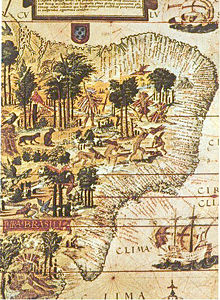
Map of Brazil issued past the Portuguese explorers in 1519.
Well-nigh scholars agree that Brazil was first reached on Apr 22, 1500, by Portuguese explorer Pedro Álvares Cabral. Initially Portugal had little involvement in Brazil, mainly because of high profits gained elsewhere. But after 1530, the Portuguese Crown devised the hereditary captaincies system to effectively occupy its new colony and afterwards took direct control of the failed captaincies. The Portuguese colonists adopted an economy based on producing agricultural appurtenances for export to Europe. Saccharide was by far the most important product until the early eighteenth century. Fifty-fifty though Brazilian sugar was reputed to be of high quality, the industry faced a crunch during the seventeenth and eighteenth centuries when the Dutch and the French started producing carbohydrate in the Antilles, located much closer to Europe, causing sugar prices to fall.
During the eighteenth century, individual explorers found gold and diamond deposits in the country of Minas Gerais. The exploration of these mines were by and large used to finance the Portuguese regal court'south debts. The predatory way in which such deposits were explored, still, burdened colonial Brazil with excessive taxes. Some of the popular movements supporting independence came near to protest the calumniating taxes established by the colonial government, but they were often dismissed with violence by Portugal. Gold production declined toward the end of the eighteenth century, starting a catamenia of relative stagnation in the Brazilian hinterland. Both Amerindian and African slave manpower were largely used in Brazil's colonial economy.
Empire

Emperor Dom Pedro II of Brazil, in 1873.
In 1808, the Portuguese court, fleeing from Napoleon Bonaparte's troops that had invaded Portugal, established themselves in the urban center of Rio de Janeiro. After João 6 returned to Portugal in 1821, his heir-apparent Pedro became regent of the Kingdom of Brazil. Following a series of political incidents and disputes, Brazil achieved its independence in 1822, and Dom Pedro became the commencement emperor.
Pedro's government was considered economically and administratively inefficient, and political pressures somewhen made him step down in 1831. He returned to Portugal, leaving behind his five-twelvemonth-former son Pedro Ii. Until Pedro II reached maturity, Brazil was governed by regents. The regency period was turbulent and marked by numerous local revolts including the Male Defection, the largest urban slave rebellion in the Americas, which took place in Bahia in 1835.
In 1840, Pedro 2 was crowned emperor. His government was highlighted past a substantial rise in coffee exports and the end of the slave trade from Africa in 1850, although slavery in Brazilian territory would only be abolished in 1888. When slavery was finally abolished, a large influx of European immigrants took place. By the 1870s, the emperor's grasp on domestic politics had started to deteriorate in the face of crises with the Roman Catholic Church, the ground forces, and slaveholders. The Republican movement slowly gained force. In the stop, the empire fell because the ascendant classes no longer needed it to protect their interests. Indeed, imperial centralization ran counter to their desire for local autonomy. By 1889, Pedro Two had stepped downwards and the republican system had been adopted.
Republic
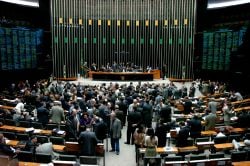
The House of Representatives at the National Congress in Brasília, the capital of Brazil.
Pedro II was deposed on Nov 15, 1889, past a republican military coup led by General Deodoro da Fonseca, who became the country's first de facto president through armed forces rise. The land's proper name became the Republic of the Us of Brazil (changed in 1967 to the Federative Democracy of Brazil). From 1889 to 1930, the dominant states of São Paulo and Minas Gerais alternated command of the presidency.
A military junta took command in 1930. Getúlio Vargas took office soon after and would remain as dictatorial ruler (with a brief democratic period in between) until 1945. He was re-elected in 1951 and stayed in part until his suicide in 1954. The successive governments continued industrial and agriculture growth and evolution of the vast interior of Brazil.
The military machine took office in Brazil in a coup d'état in 1964 and remained in power until March 1985, when it vicious from grace considering of political struggles betwixt the regime and the Brazilian elites. Just as the Brazilian government changes of 1889, 1930, and 1945 unleashed competing political forces and acquired divisions inside the military, and so likewise did the 1964 regime change. Tancredo Neves was elected president in an indirect election in 1985, as Brazil returned to a ceremonious government. He died before taking part, and the vice-president, José Sarney, was sworn in as president in his place.
Democracy was re-established in 1988 when the electric current Federal Constitution was enacted. Fernando Collor de Mello was the first president truly elected by popular vote after the military authorities. Collor took office in March 1990. In September 1992, the National Congress voted for Collor'due south impeachment after a sequence of scandals were uncovered past the media. The vice president, Itamar Franco, assumed the presidency. Assisted by the government minister of finance, Fernando Henrique Cardoso, Itamar Franco's assistants implemented the Plano Real economical package, which included a new currency, the existent, temporarily pegged to the U.South. dollar. In the elections held on October 3, 1994, Cardoso ran for president and won, and was reelected in 1998.
The peaceful transition of ability from Cardoso to his master opposition leader, Luiz Inácio Lula da Silva (elected in 2002 and re-elected in 2006), was seen equally proof that Brazil had achieved a long-sought political stability. Withal, sparked by indignation and frustrations accumulated over decades from corruption, police brutality, inefficiencies of the political establishment and public service, numerous peaceful protests erupted in Brazil from the middle of offset term of Dilma Rousseff, who had succeeded Lula after winning election in 2010. Rousseff was impeached by the Brazilian Congress in 2016.
Government and politics
The Brazilian Federation is based on the indissoluble association of three autonomous political entities: united states of america, the municipalities and the Federal District. There is no hierarchy among the political entities. The federation is based on half dozen fundamental principles: sovereignty, citizenship, dignity of the people, the social value of labor, freedom of enterprise, and political pluralism. The classic tripartite sectionalisation of power, encompassing the executive, legislative, and judiciary branches nether the checks and balances organization, is formally established past the constitution. The executive and legislative branches are organized independently in all 4 political entities, while the judiciary is organized merely in the federal and state levels.
All members of the executive and legislative branches are elected by direct suffrage. Judges and other judicial authorities are appointed afterwards passing entry exams. Voting is compulsory for those aged 18 or older.
4 political parties stand out among several modest ones: Workers' Political party (PT), Brazilian Social Democracy Party (PSDB), Brazilian Democratic Movement Party (PMDB), and Democrats (formerly Liberal Forepart Party—PFL).
Practically all governmental and authoritative functions are exercised by authorities and agencies affiliated with the executive. The course of government is republican and democratic, and the system of regime is presidential. The president is head of state and caput of government and elected for a four-twelvemonth term, with the possibility of re-election for a 2nd successive term. The president appoints the ministers of land, who assist in governing. The current president is Luiz Inácio Lula da Silva, who was elected on October 27, 2002, and re-elected on Oct 29, 2006.
Legislative houses in each political entity are the main source of laws. The National Congress is a bicameral house formed past the House of Representatives and the Federal Senate.
Foreign relations
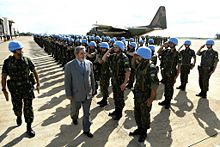
Brazilian regular army troops before boarding for MINUSTAH peacekeeping mission in Haiti.
Brazil is a political and economic leader in Latin America. Yet, social and economic issues foreclose it from becoming an effective global power. Between World War Two and 1990, both democratic and war machine governments sought to expand Brazil's influence in the globe by pursuing a state-led industrial policy and an independent foreign policy. More than recently, the state has aimed to strengthen ties with other South American countries and engage in multilateral diplomacy through the Un and the Organization of American States.
Brazil's current foreign policy is based on the state's position equally a regional power in Latin America, a leader amongst developing countries, and an emerging earth power. Brazilian foreign policy has more often than not reflected multilateralism, peaceful dispute settlement, and nonintervention in the affairs of other countries. The Brazilian constitution besides states that the country shall seek the economic, political, social, and cultural integration of the nations of Latin America.
Military machine
The military of Brazil comprise the Brazilian army, the Brazilian navy, and the Brazilian air force. The Military Police is described as an ancillary force of the ground forces but is under the command of each land's governor. The Brazilian armed services are the largest in Latin America. The Brazilian air forcefulness is the largest air strength in Latin America, with about 700 manned shipping in service. The Brazilian navy is responsible for guarding Brazilian territorial waters. It is the oldest of the Brazilian armed forces and the merely navy in Latin America that operates an aircraft carrier. With a strength of approximately 190,000 soldiers, the Brazilian army is responsible for land-based military operations.
Administrative divisions
Politically, Brazil is a federation of twenty-six states and i federal district.
The national territory was divided in 1969, into v principal regions: North, Northeast, Central-Due west, Southeast, and Southward.
The North covers 45.27 percentage of the surface of Brazil and has the lowest number of inhabitants. With the exception of Manaus, which hosts a taxation-free industrial zone, and Belém, the biggest metropolitan expanse of the region, it is fairly unindustrialized and undeveloped. Information technology accommodates most of the rainforest vegetation of the world and many ethnic tribes.
The Northeast, inhabited by nigh 30 percent of Brazil's population, is culturally diverse, with roots set in the Portuguese colonial catamenia and in Amerindian and Afro-Brazilian elements. It is also the poorest region of Brazil and suffers from long periods of dry climate. The largest cities are Salvador, Recife, and Fortaleza.
The Key-West region has low demographic density when compared to the other regions, mostly considering role of its territory is covered by the world's largest marshlands area, the Pantanal, as well as a small part of the Amazon rainforest in the northwest. Much of the region is covered by Cerrado, the largest savanna in the world. The Key-Due west region contributes significantly toward agriculture. The largest cities of this region are: Brasília (the capital), Goiânia, Campo Grande, Cuiabá, Anápolis, Dourados, Rondonópolis, and Corumbá.
The Southeast region is the richest and most densely populated. It has more inhabitants than whatever other South American country and hosts 1 of the largest megalopolises of the earth. The primary cities are the country's ii largest: São Paulo and Rio de Janeiro. The region is very diverse, including the major business concern centre of São Paulo, the historical cities of Minas Gerais and its capital Belo Horizonte, the beaches of Rio de Janeiro, and the coast of Espírito Santo.
The South is the wealthiest by Gdp per capita and has the highest standard of living in the state. It is also the coldest region of Brazil, with occasional occurrences of frost and snow in some of the higher altitude areas. It has been settled past European immigrants, mainly of Italian, German language, Portuguese, and Slavic beginnings, and has conspicuously been influenced by these cultures. The largest cities in this region are Curitiba, Porto Alegre, Florianópolis, Londrina, Caxias do Sul, and Joinville.
Economic system
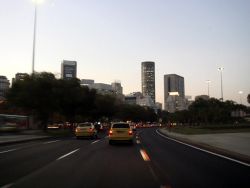
Rio de Janeiro is the second largest financial middle of the country.
Brazil'southward GDP (PPP) is the highest of Latin America, with large and developed agricultural, mining, manufacturing, and service sectors, as well equally a big labor pool. The country has been expanding its presence in international financial and bolt markets and is regarded as 1 of the grouping of 4 emerging economies. Major export products include aircraft, java, automobiles, soybeans, atomic number 26 ore, orange juice, steel, ethanol, textiles, footwear, corned beef, and electric equipment.
According to the International monetary fund and the World Banking company, Brazil has the 9th largest economic system in the world past purchasing power parity (PPP) and the tenth largest at market exchange rates. It has a diversified eye-income economy with wide variations in development levels. Most large industry is agglomerated in the South and Southeast states. The Northeast, though the poorest region, has attracted new investments in infrastructure for the tourism sector and intensive agronomical schemes.
Brazil had pegged its currency, the existent, to the U.S. dollar in 1994. However, after the East Asian fiscal crisis of 1997-1998, the Russian default in 1998, and the series of adverse fiscal events that followed it, the Brazilian central bank temporarily inverse its monetary policy to a managed-float scheme while undergoing a currency crisis, until definitively changing the exchange authorities to free-float in January 1999. Brazil received an International monetary fund rescue package in mid-2002 in the amount of United states$30.4 billion, a record sum at that time. The IMF loan was paid off early by Brazil's central bank in 2005.
Brazil has a various and sophisticated service industry. During the early 1990s, the cyberbanking sector amounted to every bit much equally xvi pct of GDP and has attracted foreign financial institutions and firms by issuing and trading Brazilian Depositary Receipts (BDRs). Ane of the issues the Brazilian central bank was dealing with in 2007 was an excess of speculative short-term uppercase inflows to the country, which might explain in function the downfall of the U.South. dollar against the existent in the menses. Nonetheless, foreign direct investment (FDI), related to long-term, less speculative investment in product, was estimated to be U.s.$193.8 billion for 2007. Inflation monitoring and command currently plays a major role in Brazil'south primal bank activeness in setting out short-term interest rates every bit a monetary policy measure.
Free energy policy
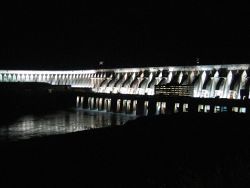
Itaipu Dam, the earth'due south largest hydroelectric found.
Brazil is the 10th largest energy consumer in the globe and the largest in Latin America. At the same fourth dimension it is likewise a big oil and gas producer in the region and the world's largest ethanol producer. Because of its ethanol fuel production Brazil has sometimes been described equally a bio-free energy superpower. Brazil's ethanol fuel is produced from sugar cane, the world's largest crop in both production and export tonnage.
After the 1973 oil crunch, the Brazilian regime initiated in 1975 the National Alcohol Program to supercede automobile fuels derived from fossil fuels with ethanol. The programme successfully reduced the number of cars running on gasoline in Brazil past 10 1000000, thereby reducing the land'south dependence on oil imports.
Brazil is the third largest hydroelectricity producer in the world, after China and Canada. In 2004 hydropower accounted for 83 percent of Brazil's power product. Brazil co-owns the Itaipu hydroelectric ability found on the Paraná River, which is the earth largest operational hydroelectric power plant.
Science and technology
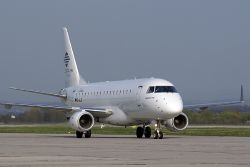
An Embraer E-175 jet airliner, produced in Brazil and used effectually the world.
Technological inquiry in Brazil is largely carried out in public universities and research institutes. Despite governmental regulations and incentives, investment in inquiry and development has been growing in private universities and companies every bit well since the 1990s. Notwithstanding, more than 73 percent of funding for basic research still comes from governmental sources. Some of Brazil'due south near notable technological hubs are the Oswaldo Cruz Institute, the Butantan Institute, the air force's Aerospace Technical Heart, the Brazilian Agronomical Enquiry Corporation, and the National Institute for Space Inquiry (INPE), a research unit of the Brazilian Ministry of Science and Technology.
Brazilian data technology is comparable in quality and positioning to those of Republic of india and China, though because of Brazil's larger internal market, software exports are limited. Catering to the internal market, Brazilian Information technology is particularly efficient in providing solutions to financial services, defence force, CRM, eGovernment, and healthcare.
Demographics
Brazil's population comprises many races and ethnic groups. The Brazilian Institute of Geography and Statistics (IBGE) classifies the Brazilian population into five categories: blackness, white, pardo (dark-brown), yellow (Asian), or ethnic, based on skin color or race. The concluding census revealed the post-obit proportions: 49.seven percent white people, 42.6 percent brown, half-dozen.nine percent blackness, 0.v per centum Asian, and 0.three percent Amerindian.
The ethnic composition of Brazilians is non compatible across the country. Because of its large influx of European immigrants in the nineteenth century, the South has a white majority, consisting of 79.half-dozen percent of its population. The Northeast, as a result of the big numbers of African slaves working in the sugar cane plantations, has a bulk of brown and black peoples, 62.5 percent and vii.8 percent, respectively. The Northward, largely covered by rainforest, is 69.two percent brown, considering of its stiff Amerindian component. Southeastern Brazil and Central-Western Brazil have a more balanced ratio among different ethnic groups.
The largest Brazilian cities are São Paulo, Rio de Janeiro, and Salvador. Almost all capitals are the largest city in their corresponding state.
Languages
Portuguese is the merely official language of Brazil. It is spoken by nearly the entire population and is nigh the only language used in schools, newspapers, radio, Goggle box, and for all business and administrative purposes. Moreover, Brazil is the just Portuguese-speaking nation in the Americas, making the language an of import part of Brazilian national identity. In add-on, 180 Amerindian languages are spoken in remote areas. There are important communities of speakers of German and Italian in the South, both largely influenced by Portuguese.
Education and health

Federal Academy of Paraná, in Curitiba.
The federal government, states, Federal Commune, and municipalities each manage their respective educational activity organisation. The new constitution reserves 25 percent of state and municipal taxes and 18 per centum of federal taxes for teaching. Individual school programs are available to complement the public school system. In 2003, the literacy rate was at 88 percent of the population, and the youth literacy charge per unit (ages 15–19) was 93.2 percent. Even so, co-ordinate to UNESCO Brazil's education however shows very low levels of efficiency by xv twelvemonth old students, especially in the public school network.
Higher teaching starts with undergraduate or sequential courses, which may offering different specialization choices such as academic or vocational paths. Depending on the option, students may amend their educational groundwork with postgraduate courses.
The public health organisation is managed and provided by all levels of government, while private health care fulfills a complementary role. Several problems hamper the Brazilian organization. In 2006, the most notable health issues were babe mortality, child mortality, maternal mortality, bloodshed by non-transmissible affliction, and bloodshed caused past external causes (transportation, violence, and suicide).
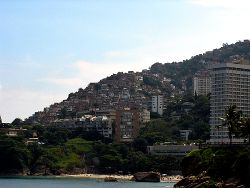
In Rio de Janeiro, the Vidigal favela is testimony to high economic inequality within Brazil.
Brazil has been unable to reflect its recent economical achievements into social development. Poverty, urban violence, growing social security debts, inefficient public services, and the low value of the minimum wage are some of the main social issues that currently challenge the Brazilian authorities.
The poverty rate is in part attributed to the country's economical inequality. Brazil has ane of the world'south highest rankings for inequality. In 2006, nearly one-fifth of the populated lived beneath the poverty line based on labor income, though that was 33 percent reduction from the previous three years.
Poverty in Brazil is most visually represented by the various favelas, slums in the metropolitan areas and remote upcountry regions that suffer from economical underdevelopment and below-par standards of living. There are also great differences in wealth and welfare between regions. While the Northeast has the worst economic indicators nationwide, many cities in the Due south and Southeast enjoy First World socioeconomic standards.
The level of violence in some big urban centers is comparable to that of a state of war zone. Analysts mostly suggest that social inequality is the major crusade. Muggings, robberies, kidnappings, and gang violence are common in the largest cities. Police brutality and corruption are widespread. Inefficient public services, peculiarly those related to security, teaching, and health, severely touch the quality of life. Minimum wages fail to fulfill their ramble requirements regarding living standards. Brazil currently ranks 69th on the Unitd Nations Human Development Index.
Culture
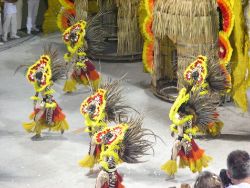
Brazilian Carnival parade in Rio de Janeiro.
A broad variety of elements influenced Brazilian culture. Its major early influence derived from Portuguese civilization. Among other inheritances, the Portuguese introduced the Portuguese language, the Roman-Germanic legal system, and colonial architectural styles. Other aspects of Brazilian culture are contributions of European and Asian immigrants, native South American people (such as the Tupi), and African slaves. Thus, Brazil is a multicultural and multiethnic order. Italian, High german, and other European immigrants came in large numbers and their influences are felt closer to the Southeast and South of Brazil. Amerindian peoples influenced Brazil's language and cuisine, and the Africans, brought to Brazil equally slaves, influenced Brazil'due south music, dance, cuisine, organized religion, and linguistic communication.
In the 1950s, Antônio Carlos Jobim, Vinícius de Moraes, Baden Powell de Aquino, and João Gilberto popularized the Bossa Nova style in music. Later Elis Regina, Milton Nascimento, Chico Buarque, and Nara Leão had an important role in shaping Música Popular Brasileira (literally translated as "Brazilian Popular Music," frequently abbreviated to MPB). In the belatedly 1960s, tropicalismo was popularized past Caetano Veloso and Gilberto Gil.
Brazilian Carnival is an annual celebration held 40 days earlier Easter that marks the beginning of Lent. Brazilian Carnival has distinct regional characteristics. Other regional festivals include the Boi Bumbá and Festa Junina (June Festivals).
Religion
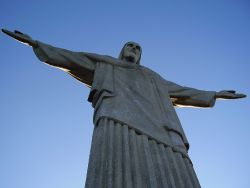
Christ the Redeemer, on Corcovado mountain.
The predominant religion in Brazil is Roman Catholicism and the state has the largest Roman Catholic population in the world. Adherents of Protestantism are rising in number. Until 1970, the majority of Brazilian Protestants were members of traditional denominations, mostly Lutherans, Presbyterians, and Baptists. Since then, membership in Pentecostal and Neo-pentecostal churches has increased significantly. Islam was beginning proficient by African slaves. Today, the Muslim population in Brazil is made up generally of Arab immigrants. A recent trend has been an increase in conversions to Islam amidst not-Arab citizens. The largest population of Buddhists in Latin America lives in Brazil, mostly because the country has the largest Japanese population exterior Nippon.
The latest census cites the following figures: 74 percent of the population is Roman Catholic (near 139 one thousand thousand); 15.iv percentage is Protestant (about 28 million), including Jehovah's Witnesses; 7.four percent considers itself agnostics or atheists or without a religion (nigh 12 one thousand thousand); one.3 percentage follows Spiritism (about 2.ii million); 0.3 percent follows African traditional religions such as Candomblé and Umbanda; and ane.seven percentage are members of other religions. Some of these are Buddhists (215,000), Jews, Muslims, or a mixture of unlike religions.
Sports
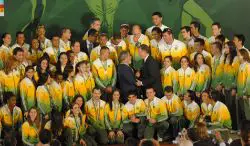
The Brazilian athletes at the 2007 Pan American Games
.
Football (soccer) is the most popular sport in Brazil. The Brazilian national football team (Seleção) has been victorious in the World Cup tournament a tape five times, in 1958, 1962, 1970, 1994, and 2002. It is ranked the best in the earth past FIFA.
Basketball, volleyball, auto racing, and martial arts also attract large audiences. Tennis, handball, pond, and gymnastics have constitute a growing number of enthusiasts in recent decades. In auto racing, Brazilian drivers have won the Formula i world title eight times.
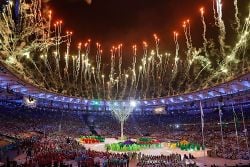
Endmost ceremony of the 2016 Summertime Olympics at the Maracanã Stadium, Rio de Janeiro
Some sport variations have their origins in Brazil. Embankment soccer and footvolley emerged in the country every bit variations of soccer. In martial arts, Brazilians accept developed Capoeira, Vale tudo, and Brazilian Jiu-Jitsu.
Brazil has hosted several loftier-profile international sporting events, like the 1950 FIFA World Cup, and recently has hosted the 2014 FIFA World Cup. Brazil as well hosted the 2016 Summer Olympic Games, where the Brazil football team won the gold medal.
Brazil has undertaken the organization of large-scale sporting events: It is organizing a bid to host the 2014 FIFA Globe Cup event. São Paulo organized the Four Pan American Games in 1963, and Rio de Janeiro hosted the 15 Pan American Games in 2007. Brazil is also trying for the fourth time to host the Summertime Olympics in Rio de Janeiro in 2016.
Notes
- ↑ Projeções da População | Estatísticas | IBGE :: Instituto Brasileiro de Geografia eastward Estatística (in pt-br). Retrieved February 19, 2019.
- ↑ two.0 two.1 ii.ii ii.3 Report for Selected Countries and Subjects: Brazil International monetary fund. Retrieved February 19, 2019.
References
ISBN links back up NWE through referral fees
- Alves, Maria Helena Moreira. Country and Opposition in Military machine Brazil. Austin, TX: Academy of Texas Press, 1985. ISBN 0292775989
- Amann, Edmund, and Werner Baer. The Illusion of Stability the Brazilian Economy Under Cardoso. Urbana, IL: University of Illinois at Urbana-Champaign, 1999.
- Bellos, Alex. Futebol: The Brazilian Fashion of Life. New York: Bloomsbury, 2002. ISBN 1582342504
- Bethell, Leslie. Colonial Brazil. Cambridge: Cambridge Academy Printing, 1987. ISBN 0521341272
- Costa, Cruz. A History of Ideas in Brazil; the Development of Philosophy in Brazil and the Development of National History. Berkeley: University of California Printing, 1964.
- Fausto, Boris. A Concise History of Brazil. Cambridge Curtailed Histories. Cambridge: Cambridge University Press, 1999. ISBN 052156526X
- Furtado, Celso. The Economic Growth of Brazil, a Survey from Colonial to Mod Times. Berkeley: University of California Press, 1963.
- Leal, Victor Nunes. Coronelismo the Municipality and Representative Authorities in Brazil. Cambridge: Cambridge University Press, 1977. ISBN 0521214882
- Malathronas, John. Brazil Life, Blood and Soul. Summersdale Travel. Chichester, West Sussex, UK: Summersdale, 2003. ISBN 1423745272.
- Martínez-Lara, Javier. Building Democracy in Brazil the Politics of Constitutional Change, 1985-95. New York: St. Martin's Press, 1996.
- Prado Júnior, Caio. The Colonial Groundwork of Mod Brazil. Berkeley: University of California Press, 1967.
- Schneider, Ronald M. Brazil Culture and Politics in a new Industrial Powerhouse. Boulder, CO: Westview Printing, 1996. ASIN B079ZBZJS6
- Skidmore, Thomas E. Blackness into White; Race and Nationality in Brazilian Idea. New York: Oxford University Printing, 1974. ISBN 0822313200
- Wagley, Charles. An Introduction to Brazil. New York: Columbia University Press, 1963.
- The World Almanac and Book of Facts. New York: Globe Annual Books, 2006. ISBN 0886879647
External links
All links retrieved February 11, 2022.
- U.South. Department of State. U.South. Relations With Brazil
Credits
New World Encyclopedia writers and editors rewrote and completed the Wikipedia commodity in accordance with New Globe Encyclopedia standards. This commodity abides by terms of the Creative Eatables CC-by-sa 3.0 License (CC-by-sa), which may be used and disseminated with proper attribution. Credit is due under the terms of this license that can reference both the New World Encyclopedia contributors and the selfless volunteer contributors of the Wikimedia Foundation. To cite this commodity click here for a list of acceptable citing formats.The history of before contributions by wikipedians is accessible to researchers here:
- Brazil history
The history of this article since information technology was imported to New World Encyclopedia:
- History of "Brazil"
Notation: Some restrictions may apply to apply of private images which are separately licensed.


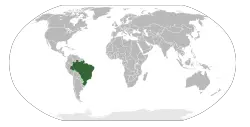
0 Response to "Environmental Regulations in Brazil for Fashion"
Post a Comment